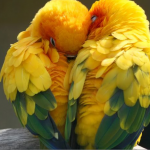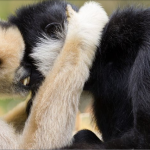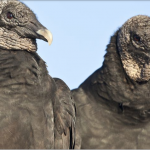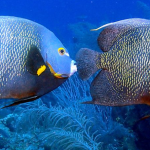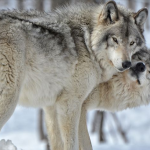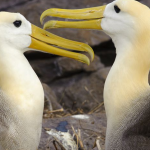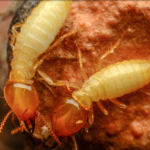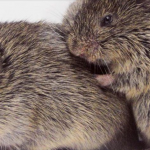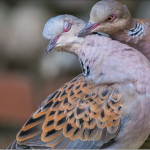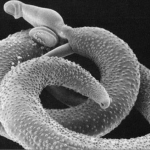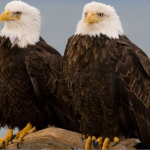Mate for life
By: Bryan Nelson From mnn
Old faithful
Humans like to think of themselves as a faithful species, but when it comes to true fidelity, many other animals offer better examples of how to keep a relationship together. Although monogamy and lifelong pair bonds are generally rare in the animal kingdom, there are some animals that pull it off.
Gibbons
Gibbons are the nearest relatives to humans that mate for life. They are monogamous, a rare trait for primates, points out National Geographic. They form extremely strong pair bonds and exhibit low sexual dimorphism, which means that males and females of the species are of roughly equal size, a testament to the fact that both sexes are on relatively equal footing.
The coupled male and female will spend time grooming each other and (literally) hanging out together in the trees. But more recent research has found that these unions are not quite as uncomplicated as once thought. With mates occasionally philandering, and even sometimes dumping a mate, the gibbon mating culture has started to look perhaps a little bit more like ours.
Swans
Swans form monogamous pair bonds that last for many years, and in some cases these bonds can last for life. Their loyalty to their mates is so storied that the image of two swans swimming with their necks entwined in the shape of a heart has become a nearly universal symbol of love.
Why birds mate for life isn’t as romantic as it first appears, though. Considering the time needed to migrate, establish territories, incubation, and raising their young, spending extra time to attract a mate would minimize reproductive time. One of the benefits of mating for life is that the swan duo learns from their successes and failures each time they raise cygnets, reports the BBC.
Black vultures
Good looks are not a prerequisite to a faithful relationship. In fact, black vulture society makes sure of that. They have been known to attack other vultures that have been caught philandering!
Researchers even looked at genetic evidence from DNA fingerprinting to study the black vulture’s monogamy. A study published in the journal Behavioral Ecology found that “mated pairs exhibit long-term pair bonding and year-round association, and share incubation and nestling feeding duties equally.” Couples that parent together stay together.
Black vultures
Good looks are not a prerequisite to a faithful relationship. In fact, black vulture society makes sure of that. They have been known to attack other vultures that have been caught philandering!
Researchers even looked at genetic evidence from DNA fingerprinting to study the black vulture’s monogamy. A study published in the journal Behavioral Ecology found that “mated pairs exhibit long-term pair bonding and year-round association, and share incubation and nestling feeding duties equally.” Couples that parent together stay together.
French angelfish
You’re unlikely to ever find a French angelfish alone. These creatures live, travel and even hunt in pairs. The fish form monogamous bonds that often last as long as both individuals are alive. In fact, they act as a team to vigorously defend their territory against neighboring pairs, reports Smithsonian.
Researchers have also observed pairs of these patterned fish traveling to the water’s surface to release their eggs and sperm together.
Wolves
Often portrayed as tricksters and con artists in popular folklore, wolves have a family life that is more loyal and pious than most human relationships. Normally, packs consist of a male, a female and their offspring, essentially making wolf packs akin to a nuclear family. The older offspring even help take care of their younger siblings.
Occasionally, a lone wolf will be welcomed into a pack. A pack can range from just three or four wolves to as many as 20, depending on the food supply in the area.
Albatrosses
An albatross may fly great distances over the oceans, but despite its extensive travels, this bird will always return to the same place — and the same partner — when it’s time to breed. Pair bonds between males and females form over several years and will last for a lifetime, cemented through the use of goofy but affectionate ritual dances. In fact, the birds will court each other for years using those dances in order to pick the perfect partner.
An albatross only lays one egg each year, so it’s important that it chooses the best partner to raise its limited number of chicks.
Termites
In an ant colony, a queen mates once with the male(s), stores the gametes for life, and the male ants die shortly after mating. In contrast, several species of termites can form lifelong pair bonds between a female “queen” and a single male “king” who literally give birth to their entire kingdom.
Termites tend to stay with the same mates for a long time, reports Nature. They might stick together for as long as 20 years in some species. If termites do break up, things can get ugly, says researcher Janet Shellman-Reeve of Cornell University. She found that relationship splits are often accompanied by physical violence. Termites may chew off each others’ antennae, for example.
Prairie voles
Although most rodents have a reputation for promiscuity, prairie voles break the trend, generally forming monogamous pair bonds that occasionally last a lifetime. In fact, the prairie vole is typically cited as an animal model for monogamy in humans. They huddle and groom each other, share nesting and pup-raising responsibilities, and generally show a high level of supportive behavior.
If a male vole shows even the slightest hint that he’s not going to stick around once babies are born, the female will grab him by the scruff of the neck, reports Smithsonian. It’s rarely necessary because, after all, the word “vole” is an anagram of the word “love.”
Turtle doves
There’s a reason that turtle doves come in pairs of two in “The Twelve Days of Christmas.” These emblems of love and faithfulness have even inspired poetry in Shakespeare, being the subject of his poem, “The Phoenix and the Turtle.”
Turtle doves are also known as mourning doves or rain doves. A male courts a female by flying to her noisily, with his wings making a distinct whistling sound. He then puffs out his chest, bobs his head repeatedly, and calls to her. She’s smitten for life.
Schistosoma mansoni worms
They may not offer the conventional image of love, but these parasitic worms are usually far more faithful than the humans they inhabit. As unromantic as it sounds, they cause the disease schistosomiasis, also known as snail fever.
When they reproduce sexually within the human body, they form loyal monogamous pair bonds that typically last the entire cycle.
Bald eagles
They are the national emblem of the United States, and when it comes to maintaining relationships, bald eagles soar much higher than the country they symbolize. Bald eagles typically mate for life, except in the event of their partner’s death or impotency — a number far lower than America’s divorce rate, which now exceeds 50 percent.
“Bald eagles stay hitched until death do they part, often returning year after year to the same nest,” Carolyn Shea wrote in Audubon. “While there, the pair continuously adds to the structure, so that after many seasons it assumes gargantuan proportions and stands as a symbol of their fidelity.”
IMAGES:
A pair of sun conures. (Photo: Julia Kuznetsova/Shutterstock)
Gibbons frequently form long-term pair bonds.(Photo: Roland Ijdema/Shutterstock
Two mute swans show off the graceful bend of their necks.(Photo: Phil Wood/flickr)
Two black vultures share a perch.(Photo: John A. Anderson/Shutterstock)
French angelfish spotted around the Turneffe Atoll, off the coast of Belize.(Photo: Adam/flickr)
Wolves share a more complex family life than you might think.(Photo: Diane Picard/Shutterstock)
An albatross finds its partner through a series of ritual dances.(Photo: Ben Queenborough/Shutterstock)
Two termites gather on brushwood.(Photo: NaibankPhotos/Shutterstock)
Prairie voles display a lot of supportive behaviors, including grooming and huddling.(Photo: Zack Johnson/Science Daily)
The faithful behavior of turtle doves even inspired Shakespeare.(Photo: Andy Morffew/flickr)
Schistosoma mansoni worms stay together.(Photo: Davies Laboratory Uniformed Services University Bethesda/Wikimedia Commons)
Bald eagles come back to the same nest, year after year.(Photo: Richard Lowthian/Shutterstock)
For more on this story go to: https://www.mnn.com/earth-matters/animals/photos/11-animals-that-mate-for-life/old-faithful


